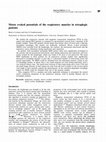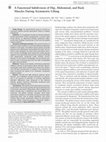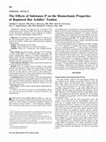Papers by Guy Vanderstraeten

Spinal Cord, Nov 1, 1996
We studied the respiratory muscles with magnetic transcranial stimulation (TCS) in four spinal co... more We studied the respiratory muscles with magnetic transcranial stimulation (TCS) in four spinal cord injured (SCI) patients as compared to age-matched controls from a database of 40 healthy subjects. These SCI patients all had spinal cord lesions above C6 level with a clinically incomplete tetraplegia. One patient was artificially ventilated. Motor evoked potentials (MEPs) were recorded from the diaphragm, the scalenes, the parasternal intercostals and the expiratory rectus abdominis during inspiration and expiration. In patients with incomplete tetraplegia MEP latency times were significantly prolonged in the scalenes and the parasternal intercostals, both during inspiration and expiration, and were nearly normal for the diaphragm, which was found to be more or less preserved. The mean MEP amplitudes in these patients for all inspiratory muscles studied were significantly decreased in tetraplegic patients, in part due to a decreased number of innervating axons and muscle hypotrophy. No MEPs could be obtained from the abdominal muscles, except in one C3 tetraplegic patient, in whom only a very small response was seen during expiration, with a very delayed latency time. The much lower location of their innervating nerve roots (TlO) and the much longer distance of their spinal exit zone from the level of injury at the cervical spinal cord might at least partially explain this phenomenon. In the ventilator-dependent tetraplegic patient no MEPs could be obtained from any of the muscles studied. Thus, magnetic TCS is a painless and easily applicable technique to investigate the central motor conduction properties of the respiratory muscles, both in healthy humans and in tetraplegic patients.
European Journal of Physical and Rehabilitation Medicine, 2012
European journal of physical medicine and rehabilitation, 1996
Endofibrosis of the external iliac artery has only recently been recognized as a possible cause o... more Endofibrosis of the external iliac artery has only recently been recognized as a possible cause of leg pain in cyclists. Due to the typical position on the bicycle (hip in hyperflexion) and to the high haemodynamic load during cycling, endofibrosis develops gradually, producing typical claudicational pain in the affected leg upon (sub)maximal effort. A case report is presented and the diagnostic and therapeutic options are discussed.

Spine, 2001
Study Design. An experimental study of muscle recruitment patterns during asymmetric lifting in h... more Study Design. An experimental study of muscle recruitment patterns during asymmetric lifting in healthy individuals. Objective. To investigate muscle recruitment patterns during asymmetric lifting, representing a common daily living activity, to determine whether systematic differences exist between functioning of the local and global muscle systems. Summary of Background Data. The normal function of the local muscle system is to provide sufficient segmental stability to the spine. The global muscle system provides general trunk stabilization and enables the static and dynamic work necessary for daily living and sports activities. Current knowledge about these two muscle groups appears to be specifically derived from anatomic findings and experiments conducted under artificial circumstances. To the authors' knowledge, the recruitment patterns of both muscle groups have not been investigated in daily living activities. Methods. Twenty-nine healthy individuals performed different variants of asymmetric lifting activities. Electromyographic data were collected from seven hip, abdominal, and back muscle pairs. In addition, trunk kinematics were measured by means of an ultrasonic movement analysis system. Results. The left and right obliquus internus, rectus femoris, and multifidus showed symmetric co-contraction in all variants of activities. In contrast, significant left/right differences were observed in the external oblique, gluteus maximus, iliocostalis lumborum pars thoracis, and latissimus dorsi. Conclusions. The results of this study show a symmetric activation of the local muscles during the performance of low-load, asymmetric lifting tasks, which suggests that these muscles play a stabilizing role during these manoeuvres. The global muscles, however, hand show asymmetric patterns of activation during the same tasks, supporting their role as global stabilizers and prime movers.

Manual Therapy, 2007
Low back pain is a major problem involving high medical costs, therefore effective prevention str... more Low back pain is a major problem involving high medical costs, therefore effective prevention strategies are essential. Stabilization exercises seem to facilitate the neuromuscular control of the lumbar spine and may be useful in prevention programs. To investigate whether specific lumbar stabilization training has an effect on muscle recruitment patterns in a healthy population, in the present study 30 subjects were recruited to perform two types of testing exercises, i.e. bridging exercises and exercises in four-point kneeling, both before and after training. Surface electromyographic data of different abdominal and back muscles were obtained. After training, analysis of the relative muscle activity levels (percentage of maximal voluntary isometric contraction) showed a higher activity of the local (segmental-stabilizing) abdominal muscles, but not of the local back muscles; minimal changes in global (torque-producing) muscle activity also occurred. Analysis of the local/global relative muscle activity ratios revealed higher ratios during all exercises after training, although not all differences were significant. These results indicate that muscle recruitment patterns can be changed in healthy subjects by means of a training program that focuses on neuromuscular control. Additional studies are needed to evaluate this type of training as a prevention strategy.

British Journal of Plastic Surgery, 1997
This study was undertaken to demonstrate that the deep inferior epigastric perforator (DIEP) flap... more This study was undertaken to demonstrate that the deep inferior epigastric perforator (DIEP) flap can provide the well-known advantages of autologous breast reconstruction with lower abdominal tissue while avoiding the abdominal wall complications of the transverse rectus abdominis myocutaneous (TRAM) flap. Eighteen unilateral free DIEP flap breast reconstruction patients were assessed 12-30 months (mean 17.8 months) after surgery. Clinical examination, physical exercises and isokinetic dynamometry were performed preoperatively and two months and one year postoperatively. Intraoperative segmental nerve stimulation, visual evaluation and postoperative CT scans were also used to quantify the damage to the rectus muscle. The 18 patients were then compared with 20 free TRAM flap patients and 20 non-operated controls. Two DIEP flap patients presented with abdominal asymmetry. A limited decrease of trunk flexing strength was noticed but rotatory function was intact. Ten of the TRAM flap patients had umbilical or abdominal asymmetry, bulging or hernias. TRAM flap patients showed a statistically significant reduction in strength to flex and to rotate the upper trunk compared to both the one year postoperative DIEP flap group and the control group. The answers to a questionnaire revealed impairment of activities of daily living for some TRAM flap patients while the activities of all DIEP flap patients were unaffected. Our data demonstrate that the free DIEP flap can limit the surgical damage to the rectus abdominis and oblique muscles to an absolute minimum. We believe it is worthwhile to spend extra operative time, the main disadvantage of this technique, to limit late postoperative weakness of the lower abdominal wall.

British Journal of Plastic Surgery, 1997
During recent years, clinical research on the donor site morbidity after free or pedicled transve... more During recent years, clinical research on the donor site morbidity after free or pedicled transverse rectus abdominis myocutaneous (TRAM) flap surgery has been focusing on the reduced flexion capacity of the abdominal wall. However, the rectus abdominis muscles have close interactions with their synergists and antagonists and collaborate with their neighbouring muscles. The purpose of this study was to examine the consequences of partially resecting the rectus abdominis muscle on the different muscle groups of the abdominal wall. Twenty free TRAM flap patients, 12-61 months (mean 32.1 months) after surgery, were clinically examined, evaluated for curl-up performance and underwent isokinetic dynamometry for flexion, extension and rotation. The patients were compared with 20 non-operated controls. Nineteen patients answered a questionnaire. Abdominal wall abnormalities occurred in 10 patients: umbilical asymmetry (n = 3), abdominal wall asymmetry (n = 4), lower abdominal bulging (n = 2) and hernia (n = 1). Curl-up performance was less in the TRAM flap patients (P = 0.001, Mann-Whitney). Isokinetic flexion, extension and rotation were also less in the TRAM flap patients (Fisher's exact test). This study indicates that what has been believed to be 'limited' surgical damage to the abdominal wall leads to an important reduction in flexion strength but to an even more important reduction of rotation strength due to bilateral displacement and damage of the insertion of the oblique muscles. Partial compensation by synergists is variable and unpredictable on an individual basis. These functional disorders can potentially lead to important changes in activities of daily life.

Journal of Electromyography and Kinesiology, 2008
Although progressive resistance training of trunk muscles on devices is very common, today, the e... more Although progressive resistance training of trunk muscles on devices is very common, today, the effects of increasing resistance on trunk muscle activity during dynamic extension and flexion movements on training devices have not been reported yet. Thirty healthy subjects participated in maximal isometric and submaximal dynamic (at 30%, 50% and 70% of maximum mean torque (MMT)) extension and flexion exercises on Tergumed lumbar training devices. The normalized (as a percentage of maximal voluntary isometric contractions (MVIC)) electromyographic activity of 16 abdominal and back muscles was investigated. The results of the present study indicated that in general, with increasing resistance from 30% MMT to 50% MMT and 70% MMT, the activity of all back muscles during the extension exercises and the activity of all abdominal muscles during the flexion exercises increased significantly. To train strength (>60% of MVIC), low intensities (30% and 50% MMT) appeared sufficient to affect the back muscles, but for the abdominals higher resistance (70% MMT) was required. In contrast to the other back muscles, the lumbar multifidus demonstrated high activity levels during both the extension and the flexion exercises. As the lumbar multifidus is demonstrated to be an important muscle in segmental stabilization of the lumbar spine, this finding may help in understanding the efficacy of rehabilitation programs using specific training devices.

Journal of Electromyography and Kinesiology, 2008
The aims of the current study were to examine the stationarities of surface electromyographic (EM... more The aims of the current study were to examine the stationarities of surface electromyographic (EMG) signals obtained from eight bilateral back and hip muscles during a modified Biering-Sørensen test, and to investigate whether short-time Fourier (STFT) and continuous wavelet transforms (CWT) provided similar information with regard to EMG spectral parameters in the analysis of localized muscle fatigue. Twenty healthy subjects participated in the study after giving their informed consent. Reverse arrangement tests showed that 91.6% of the EMG signal epochs demonstrated no significant trends (all p>0.05), meaning 91.6% of the EMG signal epochs could be considered as stationary signals. Pearson correlation coefficients showed that STFT and CWT in general provide similar information with respect to the EMG spectral variables during isometric back extensions, and as a consequence STFT can still be used.
Archives of Physical Medicine and Rehabilitation, 1995

Archives of Physical Medicine and Rehabilitation, 2006
Objective: To determine whether injection of substance P into the paratendinous region of a ruptu... more Objective: To determine whether injection of substance P into the paratendinous region of a ruptured and subsequently sutured rat Achilles' tendon alters the biomechanic properties of the tendon. Design: Interventional animal study. Setting: Animal laboratory at a university hospital. Animals: Ninety-six 2-month-old, male Sprague-Dawley rats. Intervention: Injection of saline, substance P (10-6 mol/kg of body weight [BW] or 10-8 mol/kg BW) associated with neutral endopeptidase inhibitors, or neutral endopeptidase inhibitors alone into the paratendinous region of ruptured and subsequently sutured rat Achilles' tendons from the second until the sixth day postoperatively. Main Outcome Measures: Stress at maximal load and work to maximal load and stiffness. Results: Stress at maximal load was higher in the groups injected with substance P than in the saline group in the first, second, and sixth weeks. Work to maximal load was higher from the second until the sixth weeks in the substance Ptreated groups than in the saline group. Stiffness did not differ between the 4 groups in any of the weeks. Conclusions: Injection of substance P into the paratendinous region of ruptured and subsequently sutured rat Achilles' tendons improved tendon healing by enhancing stress at maximal load and work to maximal load. However, stiffness was not significantly affected.
Van de Velde, Dominique, Van Hove, G., Bracke, P., Josephsson, S., & Vanderstraeten, G. (2010). H... more Van de Velde, Dominique, Van Hove, G., Bracke, P., Josephsson, S., & Vanderstraeten, G. (2010). How do men with paraplegia choose activities? : a qualitative study based on a phenomenological hermeneutical method. World Federation of Occupational Therapists, 15th World congress, Abstracts. Presented at the 15th World congress of the World Federation of Occupational Therapists (WFOT Congress 2010). ... Van de Velde D, Van Hove G, Bracke P, Josephsson S, Vanderstraeten G. How do men with paraplegia choose activities? : a qualitative study based on a ...











Uploads
Papers by Guy Vanderstraeten